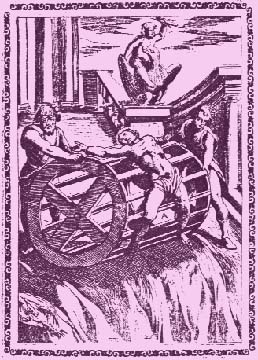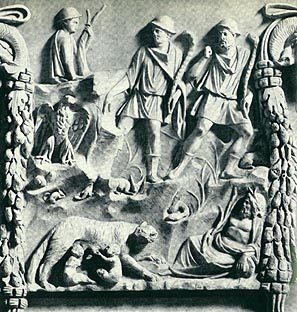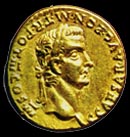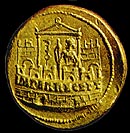A River of Blood
And Yield They Did.
In 1122 Christian crusaders swept over Jerusalem and slaughtered men, women and children, 'until their horses were knee deep in blood. We then went to the church to thank the Lord for his mercy.'
In 777 , Charlemagne, a devout Christian, after conquering the Saxon rebels, gave them a choice between baptism and execution. When they refused to convert, he had 4500 of them beheaded in one morning.
In the fourth century, Emporor Constantine, the first Roman Emperor to become a Christian, had over 3000 Christians executed because their interpretation of the Bible did not agree with his. That is more than the number of Christians who died at the hands of the Romans during the well known 1st century "Christians to the lions" persecutions.
The above are from William Manchester's "A World Lit Only by Fire- The Medieval Mind and The Renaissance"..Little, Brown & Company, 1992
Queen Isabella, famous for sending Columbus to the New World
in 1492, was well known also for her 'Spanish Inquisition',
the gruesome torture and murder of tens of thousands of
Spanish Jews, Muslims, homosexuals, people who read or wrote,
uppity women, and anyone else not up to the Queen's strict standards. Isabella was a champion of the faith,
piously congratulating herself as her victims writhed
to their deaths in the flames and the many other ingenious
methods of torture invented by her inquisitors.
strict standards. Isabella was a champion of the faith,
piously congratulating herself as her victims writhed
to their deaths in the flames and the many other ingenious
methods of torture invented by her inquisitors.
 Of course, the presence of torture did not always mean the presence of the Christian Church, and vice-versa. History is spotty; key things are left out or included inordinately - we don't always know. The church was active in many places with no record of the Inquisition in the same area; and
in other cases the two went hand in hand.
Of course, the presence of torture did not always mean the presence of the Christian Church, and vice-versa. History is spotty; key things are left out or included inordinately - we don't always know. The church was active in many places with no record of the Inquisition in the same area; and
in other cases the two went hand in hand.
In the 12th and 13th centuries, the Inquisition was born, with Christians killing Christians, during what was known as the Albigensian heresies. Hundreds of thousands of people died because their Christianity did not agree with official dogma. This adds to the irony of murder in the name of Christ, when the majority of victims of the early inquisitions were themselves Christians.
English Catholics suffered horribly under Protestant regimes. American historian William T. Walsh writes: "In Britain, 30,000 went to the stake for witchcraft; in Protestant Germany, the figure was 100,000" (, p. 275). In Scotland, too, alleged witches were cruelly put to death. Karl Keating quotes from the : "It is well-known that belief in the justice of punishing heresy with death was so common among the 16th-century Reformers-Luther, Zwingli, Calvin, and their adherents-that we may say their toleration began where their power ended" (C.E., s.v., "Inquisition," 8:35). From an article exonerating (to some extent) the Catholics, Here.
Historical quibbling aside, one sees the general trend. 1000 year old oak trees that had been sacred to the pagans were hacked down and replaced with cathedrals. The altar was often built on the stump of the tree; some altars are built over boulders or embedded stones that were ancient Pagan ritual sites.
As Christianity took over Europe, attempts to supress Pagan holy day celebrations met fierce resistance. Their solution was to absorb these holidays, purloin them, and make them into Christian holidays.
ROME

The traditional legend of the founding of Rome has it that Romulus and Remus, twin brothers, were cast into the Tiber river by their wicked great-uncle, but survived, and were suckled by a she-wolf. Romulus and Remus grew into men, and founded Rome on April 21, 753 BC. Rome was ruled by Etruscan kings until the late 6th century BC, when the Republic was established. |
This great political machine lasted nearly 1,000 years, and conquered most of the western world. Following the Greeks, the Romans created their Ideal society.
The Romans though, did not leave us with delicate art, poetry and philosophy like the Greeks. The Roman legacy was political structure, concepts of legal administration, and the Catholic Church.
A few thousand farmers occupying seven hills by the Tiber River, in what is now Italy, consolidated their power, and after a few hundred years of persistent growth, came to dominate the Italian peninsula in about 250 B.C. Within another hundred years, the Romans controlled the entire Mediterranean world.

GAIUS, called 'Caligula' ('little boots'), a late Julio-Claudian Roman Emporor, stepped up tyranny and campaigned on the Rhine, but his cruelties and probable insanity provoked the Praetorian guard. He was assassinated in 41 A.D. |

CLAUDIUS, made emporor by the Praetorian guard despite the senate, (the coin shows him in their camp) invaded Britain and brought Gauls into the senate. He was poisoned by his wife in 54 A.D. |

NERO wasted fortunes, was arbitrary and cruel, and an absolute tyrant. He murdered his mother, his pregnant wife (he kicked her to death), and many prominent Romans. He sought to be a performer, but his crimes provoked rebellion and his suicide in 68 A.D. |
Originally Pagan, Romans followed a variety of religions.
Rome became Christian because of Emporor Constantine, who had a vision the night before a battle in 312 C.E., against Maxentius at Saxa Rubra.
- The cult of Dionysus came from the Greeks; initiates were assured of immortality in a happy after world. Dionysian rites brought enthousiasmos, the Greek entheos, or being "full of God." This is the root of our word "enthusiasm." Their rituals involved a blood sacrifice, of a sanctified human, heifer or goat, and sparagmos, where the parts were scattered or eaten to seed new life.
- The cult of Cybele, the Mother-Goddess, came from Asia Minor as early as 204 B.C. Besides guidance and protection from the Mother, an annual ritual celebrated the death/rebirth of the Mother's consort, the young Attis. Mourning was followed with orgiastic frenzy, inspired by the promise of immortality. Priests of Cybele flagellated themselves, castrated themselves, and were then drenched in the blood of a sacrificed bull.
- The Cult of Isis centered on the story of the Mother-Goddess, and the death and dismemberment of her consort Osiris, at the hands of his enemy, Set. The devoted Isis searches for his remains, and establishes shrines in the places she finds them. She reassembles and regenerates him; hence the Isis cult's version of eternal life. Isis is often depicted with her son, Horus, in her lap. Depictions of the Virgin Mary with baby Jesus are the Christian Isis.
He dreamed of a cross in the sky, and a purple banner with the Greek letters CHI and RHO, which evolved into the traditional icthys symbol. On the cross were inscribed the words "in hoc signo vinces" - "in this emblem we will prevail." He had his soldiers paint crosses on their shields and they were victorious, and so he became a convert. He established the City of Constantinople on May 11, 330, at the site of old Byzantium, his homeland, and what is today Istanbul. It was the first Christian city, and for a time was the center of the Church. Constantine dispensed with the Roman court trappings, and lived in opulent Moorish style.
Eusebius, a historian of the time, says Constantine was very superstitious, and maintained images from several of the other contemporary religions. He instituted a complex system of ornate ritual into the Church rites, some of which persist today, especially in the eastern churches. He wore fabulous costumes, jewelry, tinted wigs, and was wantonly cruel. He believed that he would become an apostle after he died, and would be prayed to.
At the time of Constantine's conversion, Christianity was still collection of minor cults. Pagan Romans thought they had another nutcase-emporor on their hands. And indeed, persecution of the pagans began in earnest, by 390 CE. Bureaucratic mismanagement had reduced the government to a morass of wasted money, and the roads were falling apart.
But Christianity brought a new focus to Rome- it actually helped it sustain itself for another hundred years or so. Christianity's emphasis on self-discipline kept the behemoth alive a little longer. The Catholic church has also faithfully kept the language and legalistic Roman heritage alive to this day. The Church strengthened itself also by adopting the machinery of government. Eusebius notes that early Popes, Cardinals and Bishops often bought their way into office, or were selected from the military officer core.
Having sustained itself for 1000 years on plundered riches, the Roman empire had built a huge reservoir of resentment among people of every walk of life. When neighboring people started crowding in, like they do everywhere today, disgruntled, senate-abused taxpayers didn't put up too much of a fight.
"Invaders" were more like "settlers," and acquired land by "squatting." Whole settlements of "foreigners" had established themselves for decades, further and further into the empire, in a similar vein as what goes on in the Balkans today.
In 476, revolting Visigoths, led by Alaric, sacked the city of Rome. The Roman army had dwindled to nothing, and a band of angry settlers sent a message to history - and though the government held together even after 476, the Sack of Rome is considered to have been the death knell for the 1000 year old empire.
The Fall of Rome took 150 years, and is in fact difficult to date. Long after whole sections had been occupied by Visigoths and Vandals, even after the Sack of Rome, it still called itself Rome. The last Roman Emporor, (Romulus coincidentally) was dismissed by a guard, and went to live on the beach.
From about 500 until the end of the 15th century, Europe languished in 1000 years of superstitious, plague-ridden ignorance. (One thousand years is the amount of time from now back to the year 1000) All of the old wisdom was systematically blotted out and replaced with Catholic dogma.
The legendary Roman roads that had networked the empire were all gone, so trade became impossible. People lived in protected villages and only went outside at great risk, because of bandits and the general state of anarchy. There was continuous, dire poverty, hunger was a permanent part of life.
Without Roman industry and mining, iron was forgotten. To own an iron tool was a sign of great wealth. Medieval legends are filled with peasants in despair because they have dropped a sickle down the well, and so the intervention of an angel, or some sort of miracle, is necessary to recover it: the sickle is irreplaceable.
Without tools, farming became more difficult. A slow recovery began with the introduction of broad beans, peas, and other legumes in 1000.
The "Age of Faith", the 1000 years of the Dark Ages, was marked by a very low standard of living for most people. They lived in filth, sanitation being considered too sensual to be pious. The average life expectancy was only 25 or 30, and Bubonic Plague, Typhus and a host of other diseases regularly decimated hundreds of thousands of people. In the winter of 1349, 120,000 people died in England, one out of every three. Continental Europe had similar death counts during the 1300's, recurring waves of plague sweeping the countrysides, whole towns dying in days.
The church encouraged ignorance among the general populace: Saint Bernard of Clairvaux (1090-1153), the most influential Christian of his time, bore a deep distrust of the intellect and declared "that the pursuit of knowledge, unless sanctified by a holy mission, was a pagan act and therefore vile."
Behind closed doors, the Church kept what knowledge there was alive, and deserve grudging thanks for that at least. But the missionary zeal of Christians was equalled only by their ruthlessness, and hundreds of thousands of natives of both hemispheres have gaven their lives to the bringers of the new faith, all in the name of the 'Prince of Peace.'
A More Detailed Study of Torture (Very disturbing - not for everyone)
Saul of Tarsus, Cults of Mithras, and Christ's Blood
Borgia Popes/ Vatican Orgies/ The Black Plague
Optimized for Netscape.......Mileage may vary

webmaster

